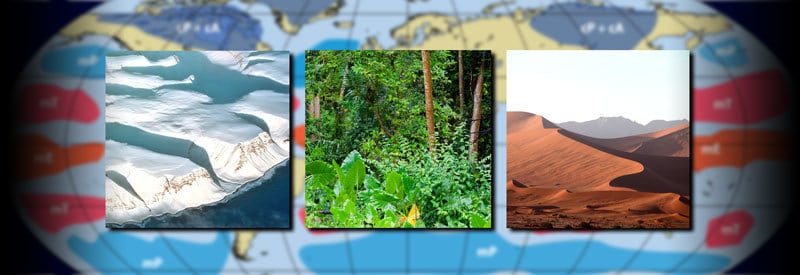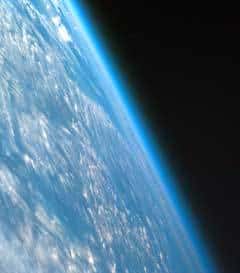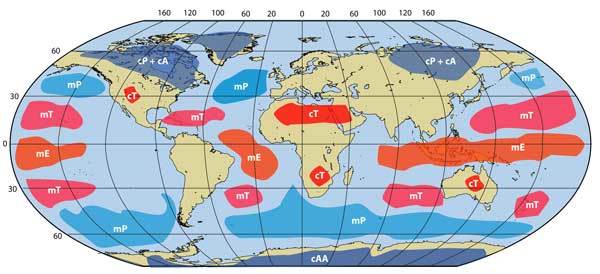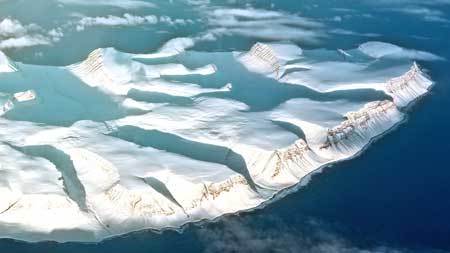What type of air mass would you expect to find over the Sahara Desert?

The terms in the title of this article may sound confusing, but they all course part of the six types of global air masses that cover the Globe'southward surface and impact the weather atmospheric condition of individual regions.
Six Primary Types Of Global Air Masses
-
one
Continental Arctic (cA) / Continental Antarctic (cAA) -
2
Continental Polar (cP) -
3
Maritime Polar (mP) -
four
Continental Tropical (cT) -
5
Maritime Tropical (mT) -
half dozen
Maritime Equatorial (mE)
At any given time, all regions throughout the earth are covered with vast bodies of air. Each one has its specific atmospheric conditions that define the weather in the expanse it covers.
Depending on multiple factors, any country can experience more than than one air mass. It is not just due to its location, which may lie on the boundary between different air masses, only likewise as a upshot of prevailing winds that can move air masses from their position.
This article explores what an air mass is, looks at its characteristics, then provides an in-depth explanation of the different types of air masses.
Air Mass Definition
The climate of whatever region in the world is largely adamant past observing the characteristics of the air mass that occupies it. (Weather can cause brusk-term atmospheric changes, but the stable air mass determines the prevailing weather weather of a vast territory.)
Earlier we examine the major air masses that encompass the world in more particular, one needs first to gain a articulate understanding of what precisely an air mass is:
What Is An Air Mass?

Air mass is the meteorological term for a volume of air with a constant temperature and humidity covering an area. It varies in size from hundreds to thousands of miles. It remains positioned over a region for extended periods and, as a result, takes on the characteristics of the surface information technology covers.
These vast bodies of air that spread out horizontally for upwardly to thousands of miles areseparated from one another past conditions fronts. It is in and around atmospheric condition fronts on the boundary between air masses that the bulk of meteorological activeness takes identify.
The characteristics of the kind of weather that occurs on the border between air masses depend on the type of weather condition front nowadays. Weather fronts vary from the more familiar cold and warm fronts to the less familiar stationary and occluded fronts.
(You lot tin acquire more nigh a cold and warm front and their associated weather in this commodity. You tin acquire all about a stationary front hither and go far-depth data well-nigh an occluded front in this post.)
The region over which an air mass forms is called a source region. This region can be a land surface or torso of h2o.
Although air masses spread out horizontally over large distances, they can also accomplish high altitudes with heights of up to sixteen km (x miles), well into the stratosphere.
Types Of Air Masses
A number of classification systems exist to categorize the major global air masses. Of them, the Bergeron Classification Organization has been the most widely acknowledged and adopted.

Global Air Masses: Continental Arctic/Antarctic (cA/cAA), Maritime Polar (mP), Continental Polar (cP), Maritime Tropical (mT), Continental Tropical (cT), and Maritime Equatorial (mE)
According to this arrangement, the classification of air masses first takes place according to the source regions from where they originate. At that place are four primal regions classified according to their latitude:
- Arctic/Antarctic Air Mass
- Polar Air Mass
- Tropical Air Mass
- Equatorial Air Mass
A capitalized initial identifies each of these regions. It means A stands for Arctic/Antarctic, P stands for Polar, T stands for Tropical, and E for Equatorial.
But the source region is not the only factor that determines the attributes of an air mass. The amount of moisture in an air mass too plays a significant office in forming its characteristics, which is primarily the result of the type of surface over which it occurs.
Two types of surfaces take the almost significant influence on moisture levels:
- Continental
- Maritime
Continental surfaces point to landmasses like continents, while maritime surfaces refer to bodies of h2o. The lowercase initial of each type of surface gets placed in front of the capitalized initial of the source region when identifying a landmass.
For example, "mP" refers to Maritime Polar, while "cT" refers to Continental Tropical.
(A 3rd lowercase letter sometimes gets placed at the end of the first two to create an fifty-fifty more accurate description of an air mass. "k" refers to an air mass that is colder than the surface below, while "due west" refers to an air mass warmer than the underlying surface.)
Vi primary types of air masses covering the planet emerge when you combine the source region with the kind of surface underlying an air mass:
Six Primary Types Of Global Air Masses
-
i
Continental Arctic (cA) / Continental Antarctic (cAA) -
2
Continental Polar (cP) -
three
Maritime Polar (mP) -
iv
Continental Tropical (cT) -
5
Maritime Tropical (mT) -
vi
Maritime Equatorial (mE)
The abbreviation for each master air mass is noted side by side to the full description. Equally described, the outset lowercase letter indicates the blazon of surface, while the second uppercase alphabetic character represents the source region of the air mass.
The influence of both the source region and blazon of surface is evident in the characteristics of any overlying air mass. This will quickly become articulate as one takes a closer look at each of the primary air masses:
Continental Arctic / Continental Antarctic Air Mass
The Continental Arctic (cA) Air mass develops over the ice-covered regions of the N Pole and Greenland. It mainly takes place over the ice and snow covering the area and therefore is classified as continental.

This air mass only takes identify during the winter when solar radiation during the twenty-four hour period is almost nonexistent. The icy conditions, combined with a lack of wet, creates very cold and dry out atmospheric weather.
Information technology'south no surprise then that the Chill Air Mass is colder than other types of air masses.
The Continental Antarctic (cAA) Air Mass develops solely over the continent of Antarctica. Since it only develops over land, it is likewise classified as continental.
The air is extremely dry and cold as a result of the icy surface and lack of moisture. It is the coldest of all air masses, including the Arctic Air Mass, no matter the time of year or flavor.
Continental Polar Air Mass
Continental Polar (cP) Air Masses develop over the landmasses of subpolar regions. They primarily bear on areas at loftier latitudes like Canada, the Northern The states, also equally Northern Asia.
It is characterized past cold, dry weather with little cloud cover and atmospheric precipitation, especially during the winter. The high-force per unit area system that exists over a region experiencing a Continental Polar Air Mass allows for a very stable body of air.
When information technology moves south, these air masses start to change equally it moves over warmer surfaces and gets subjected to longer and more intense periods of solar radiations. In render, it can provide a pleasant reprieve from warm weather during the summer months.
Maritime Polar Air Mass
Maritime Polar (mP) Air Masses form over the freezing North Atlantic and Pacific Oceans near the Chill. As a event, they are characterized by cold, moist, and unstable weather.
When it originates straight over the water, the air mass can influence side by side coastlines. For instance, the polar air that originates over the North Atlantic has a significant event on the northeastern part of the U.s.a..
Maritime Polar Air Masses can also commencement over state and move over a body of h2o. The continental polar air over Asia moves eastward over the North Pacific, where it picks up moisture from the surface and develops into a Maritime Polar Air Mass.
The moisture content in this grade of air mass is less than the wet found in Maritime Tropical Air Masses.
The precipitation associated with Maritime Polar Air is characterized by light only persistent drizzles or pelting showers. Depending on the flavour and severity, it can also produce more moderate showers besides as snowfall.
The air mass impacts the temperatures of the adjacent coastlines differently throughout the year. During the summer, it brings cooler air to the country, while the moderate air mass warms the littoral and edge regions during the cold winter months.
Continental Tropical Air Mass
Continental Tropical (cT) Air Masses class approximately 25 degrees north and south of the Equator over the dry out, mostly arid regions of the world. It mainly occurs over deserts, including the Sahara, the deserts of United mexican states, Australia, and the Arab Peninsula.

As a result of the source region and low latitude, Continental Tropical Air Masses are characterized by hot and dry weather condition weather.
Due to the nature of desert weather, temperatures driblet as sharply in the evenings as they ascent during the day, leading to farthermost contrasts in atmospheric conditions.
Continental Tropical Air Masses are often associated with prolonged dry weather weather condition, which can lead to severe droughts in affected regions. Similarly, extreme weather condition phenomena similar heatwaves are too more prone to occur in these atmospheric atmospheric condition.
Maritime Tropical Air Mass
As the name suggests, Maritime Tropical (mT) Air Masses mainly occur over the warm oceans of the Tropics and Subtropical Regions. They cover vast areas of the S Atlantic, Indian, and South Pacific Oceans.
With their location near the Equator (with its loftier levels of incoming solar radiation), combined with the ocean surface, Maritime Tropical Air Masses are characterized past very hot and humid weather condition conditions.
They are responsible for a large role of the cloud embrace and precipitation in neighboring landmasses. In the United States, a large percentage of the country's rainfall is the result of Maritime Tropical Air. It is as well responsible for the bulk of the land'due south thunderstorms.
(Information technology is also the near dominant air mass over the United Kingdom and is responsible for a large per centum of the country's precipitation.)
Maritime Equatorial Air Mass
Air Masses at or nigh the Equator primarily class over h2o, and as a upshot, are all referred to equally Maritime Equatorial Air Masses. (The small portions of land that it covers consist mostly of rainforests and not exposed dry land.)

Due to the surface and latitude over which they form, these air masses are hot and very humid. The high wet levels in the air mass are responsible for the large volume of atmospheric precipitation that occurs over country in the region.
For example, the rainforests of Central Africa and the Amazon in South America receive high volumes of rainfall throughout the year as a result of the Equatorial Air Mass.
Air Mass Facts
The following list has been compiled to aid in summarizing and highlighting the essential facts about air masses and their characteristics.
Each of these fundamental facts is fully covered and explained in previous sections of this article. You tin can find more information on each topic by simply post-obit the advisable heading.
Conclusion
This article clearly illustrated the importance of the world's air masses. They play a crucial role in the germination of the weather and climate patterns that we attribute to different regions and countries throughout the year.
Each air mass is clearly defined and differentiated from 1 another by the source region from where it originated, every bit well equally the blazon of underlying surface (country or water). This became evident while describing the characteristics of each of the major air masses.
This postal service described what an air mass is, how it forms, and also went on to explicate the different types of air masses and their attributes in more item.
Never miss out again when another interesting and helpful article is released and stay updated, while too receiving helpful tips & information past but following this link .
Until next fourth dimension, go along your eye on the weather!
Also Read
Source: https://ownyourweather.com/the-types-of-air-masses/
0 Response to "What type of air mass would you expect to find over the Sahara Desert?"
Post a Comment